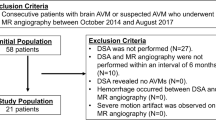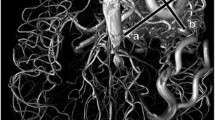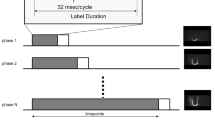Abstract
Introduction
This study was conducted in order to evaluate the value of time-resolved contrast-enhanced magnetic resonance angiography (TR-CE-MRA) with a 3.0-T magnetic field compared to digital subtraction angiography (DSA) as the reference standard for the diagnosis of brain arteriovenous malformation (bAVM).
Methods
Nineteen patients with 19 angiographically confirmed untreated bAVM were investigated with both DSA and TR-CE-MRA for the initial diagnosis. Examinations were compared by two independent readers. Interobserver agreement and intermodality agreement with respect to nidus size, arterial feeders, and venous drainage were determined using the K statistic test. Also, the quality of the TR-CE-MRA images was evaluated.
Results
Seventeen of the 19 bAVM (89.5%) detected with DSA were diagnosed with TR-CE-MRA. Interobserver agreement for TR-CE-MRA was good for nidus size, venous drainage, and arterial feeders (K = 0.75, 95% CI 0.50–1.00; K = 0.77, 95% CI 0.54–1.00; and K = 0.80, 95% CI 0.59–1.00 respectively). Intermodality agreement was good for nidus size and venous drainage (K = 0.75, 95% CI 0.49–1.00 and K = 0.77, 95% CI 0.54–1.00, respectively) and moderate for arterial feeders (K = 0.44, 95% CI 0.17–0.70).
Conclusion
TR-CE-MRA at 3.0 T has a good sensitivity for bAVM detection and good agreement with DSA for determining nidus size and the type of venous drainage, suggesting that TR-CE-MRA is potentially a reliable tool for the diagnosis and assessment of bAVMs. However, it still suffers from low spatial resolution and vessel superposition, making differentiation of the arterial feeders of the nidus difficult at times.





Similar content being viewed by others
Abbreviations
- 2D:
-
Two-dimensional
- 3D:
-
Three-dimensional
- 4D:
-
Four-dimensional
- ACA:
-
Anterior cerebral artery
- bAVM:
-
Brain arteriovenous malformation
- BG:
-
Basal ganglia
- CENTRA:
-
Contrast-enhanced robust-timing angiography
- CT:
-
Computerized tomography
- DSA:
-
Digital subtraction angiography
- Embo:
-
Embolization
- F:
-
Female
- FOV:
-
Field of view
- GK:
-
Gamma knife
- L:
-
Left
- M:
-
Male
- MCA:
-
Medium cerebral artery
- MIP:
-
Maximum intensity projection
- MRA:
-
Magnetic resonance angiography
- MRI:
-
Magnetic resonance imaging
- PCA:
-
Posterior cerebral artery
- PICA:
-
Posterior inferior cerebellar artery
- R:
-
Right
- SENSE:
-
Sensitivity encoding
- TR-CE-MRA:
-
Time-resolved contrast-enhanced magnetic resonance angiography
References
Choi JH, Mohr JP (2005) Brain arteriovenous malformations in adults. Lancet Neurol 4:299–308
Da Costa L, Wallace MC, Ter Brugge KG et al (2009) The natural history and predictive features of hemorrhage from brain arteriovenous malformations. Stroke 40:100–105
Kaufmann TJ, Huston J 3rd, Mandrekar JN et al (2007) Complications of diagnostic cerebral angiography: evaluation of 19,826 consecutive patients. Radiology 243:812–819
Fifi JT, Meyers PM, Lavine SD et al (2009) Complications of modern diagnostic cerebral angiography in an academic medical center. J Vasc Interv Radiol 20:442–447
Thiex R, Norbash AM, Frerichs KU (2010) The safety of dedicated-team catheter-based diagnostic cerebral angiography in the era of advanced noninvasive imaging. AJNR Am J Neuroradiol 31:230–234
Parmar H, Ivancevic MK, Dudek N et al (2009) Neuroradiologic applications of dynamic MR angiography at 3T. Magn Reson Imaging Clin N Am 17:63–75
Willems PW, Taeshineetanakul P, Schenk B et al (2012) The use of 4D-CTA in the diagnostic work-up of brain arteriovenous malformations. Neuroradiology 54:123–131
Saliou G, Krings T, Rutgers DR et al (2011) PWI–MRI and contrast extravasation in brain AVM help to estimate angiogenic activity. Neuroradiology 53:793–800
Ozsarlak O, Van Goethem JW, Maes M et al (2004) MR angiography of the intracranial vessels: technical aspects and clinical applications. Neuroradiology 46:955–972
Wang Y, Johnston DL, Breen JF et al (1996) Dynamic MR digital subtraction angiography using contrast enhancement, fast data acquisition, and complex subtraction. Magn Reson Med 36:551–556
Griffiths PD, Hoggard N, Warren DJ et al (2000) Brain arteriovenous malformations: assessment with dynamic MR digital subtraction angiography. AJNR Am J Neuroradiol 21:1892–1899
Mori H, Aoki S, Okubo T et al (2003) Two-dimensional thick-slice MR digital subtraction angiography in the assessment of small to medium-size intracranial arteriovenous malformations. Neuroradiology 45:27–33
Weiger M, Pruessmann KP, Kassner A et al (2000) Contrast-enhanced 3D MRA using SENSE. J Magn Reson Imaging 12:671–677
Gauvrit JY, Law M, Xu J et al (2007) Time-resolved MR angiography: optimal parallel imaging method. AJNR Am J Neuroradiol 28:835–838
Mori H, Aoki S, Masumoto T et al (2002) Two-dimensional magnetic resonance digital subtraction angiography using array spatial sensitivity encoding techniques in the assessment of intracranial hemodynamics. Radiat Med 20:223–229
Gauvrit JY, Leclerc X, Oppenheim C et al (2005) Three-dimensional dynamic MR digital subtraction angiography using sensitivity encoding for the evaluation of intracranial arteriovenous malformations: a preliminary study. AJNR Am J Neuroradiol 26:1525–1531
Willinek WA, Gieseke J, Conrad R et al (2002) Randomly segmented central k-space ordering in high-spatial-resolution contrast-enhanced MR angiography of the supraaortic arteries: initial experience. Radiology 225:583–588
Willinek WA, Hadizadeh DR, von Falkenhausen M et al (2008) 4D time-resolved MR angiography with keyhole (4D-TRAK): more than 60 times accelerated MRA using a combination of CENTRA, keyhole, and SENSE at 3.0T. J Magn Reson Imaging 27:1455–1460
Raoult H, Ferré JC, Morandi X et al (2010) Quality-evaluation scheme for cerebral time-resolved 3D contrast-enhanced MR angiography techniques. AJNR Am J Neuroradiol 31:1480–1487
Spetzler RF, Martin NA (1986) A proposed grading system for arteriovenous malformations. J Neurosurg 65:476–483
Petkova M, Gauvrit JY, Trystram D et al (2009) Three-dimensional dynamic time-resolved contrast-enhanced MRA using parallel imaging and a variable rate k-space sampling strategy in intracranial arteriovenous malformations. J Magn Reson Imaging 29:7–12
Hadizadeh DR, von Falkenhausen M, Gieseke J et al (2008) Cerebral arteriovenous malformation: Spetzler–Martin classification at subsecond-temporal-resolution four-dimensional MR angiography compared with that at DSA. Radiology 246:205–213
Eddleman CS, Jeong HJ, Hurley MC et al (2009) 4D radial acquisition contrast-enhanced MR angiography and intracranial arteriovenous malformations: quickly approaching digital subtraction angiography. Stroke 40:2749–2753
Taschner CA, Gieseke J, Le Thuc V et al (2008) Intracranial arteriovenous malformation: time-resolved contrast-enhanced MR angiography with combination of parallel imaging, keyhole acquisition, and k-space sampling techniques at 1.5T. Radiology 246:871–879
Oleaga L, Dalal SS, Weigele JB et al (2010) The role of time-resolved 3D contrast-enhanced MR angiography in the assessment and grading of cerebral arteriovenous malformations. Eur J Radiol 74:117–121
Du R, Dowd CF, Johnston SC et al (2005) Interobserver variability in grading of brain arteriovenous malformations using the Spetzler–Martin system. Neurosurgery 57:668–675
Reinacher PC, Stracke P, Reinges MH et al (2007) Contrast-enhanced time-resolved 3-D MRA: applications in neurosurgery and interventional neuroradiology. Neuroradiology 49:S3–S13
Combaz X, Levrier O, Moritz J et al (2011) Three-dimensional rotational angiography in the assessment of the angioarchitecture of brain arteriovenous malformations. J Neuroradiol 38:167–174
Wong GK, Siu DY, Ahuja AT et al (2010) Comparisons of DSA and MR angiography with digital subtraction angiography in 151 patients with subacute spontaneous intracerebral hemorrhage. J Clin Neurosci 17:601–605
Zou Z, Ma L, Cheng L et al (2008) Time-resolved contrast-enhanced MR angiography of intracranial lesions. J Magn Reson Imaging 27:692–699
Robson PM, Dai W, Shankaranarayanan A et al (2010) Time-resolved vessel-selective digital subtraction MR angiography of the cerebral vasculature with arterial spin labeling. Radiology 257:507–515
Xu J, Shi D, Chen C et al (2011) Noncontrast-enhanced four-dimensional MR angiography for the evaluation of cerebral arteriovenous malformation: a preliminary trial. J Magn Reson Imaging 34:1199–1205
Conflict of interest
We declare that we have no conflict of interest.
Author information
Authors and Affiliations
Corresponding author
Rights and permissions
About this article
Cite this article
Machet, A., Portefaix, C., Kadziolka, K. et al. Brain arteriovenous malformation diagnosis: value of time-resolved contrast-enhanced MR angiography at 3.0T compared to DSA. Neuroradiology 54, 1099–1108 (2012). https://doi.org/10.1007/s00234-012-1024-x
Received:
Accepted:
Published:
Issue Date:
DOI: https://doi.org/10.1007/s00234-012-1024-x




